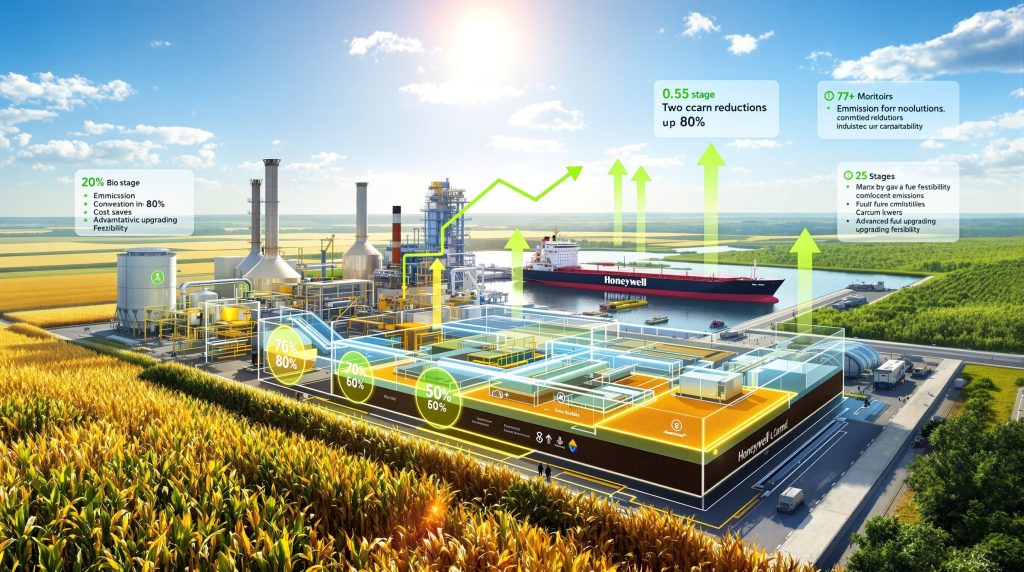What Makes Honeywell's Biocrude Innovation Different From Traditional Biofuel Production?
Honeywell biocrude technology for sustainable fuel marks a transformative leap in renewable marine fuels by shifting away from costly, food-grade feedstocks and harnessing an untapped resource: abundant agricultural and forestry residues. Traditional biofuels often depend on vegetable oils or animal fats, which not only compete with global food supplies but are also vulnerable to price volatility and limited scalability. Furthermore, Honeywell's innovative biocrude upgrading technology uses materials such as wood chips, crop stubble, nutshells, and bark—resources typically regarded as waste or in need of disposal.
The essence of this innovation lies in its two-stage processing chain. Initially, local facilities at feedstock collection points convert raw biomass into a dense, stable biocrude. Following this, the biocrude is transported to centralised hubs for advanced upgrading utilising proprietary catalysts and reactor designs. This model greatly decreases transportation costs, boosts energy density, and enables on-site waste valorization strategies.
Key Technical Advantages Over HEFA-Based Systems
| Comparison Factor | Honeywell Biocrude | Traditional HEFA |
|---|---|---|
| Primary Feedstock | Agricultural/forestry waste | Vegetable oils, animal fats |
| Feedstock Cost | Low (waste materials) | High (food-grade oils) |
| Energy Density | Enhanced through upgrading | Standard biodiesel levels |
| Carbon Efficiency | Optimised multi-stage process | Single-stage processing |
| Scalability | Modular deployment | Large centralised facilities |
This divergence not only alleviates supply chain pressure but also allows regions with excess agricultural waste or timber industry byproducts to contribute to decarbonisation efforts profitably.
Why Are Maritime Operators Prioritising Drop-In Biocrude Solutions?
The maritime sector faces intensifying demands to reduce emissions. New regulations from the International Maritime Organisation stipulate a 20% cut in greenhouse gas intensity from shipping by 2030, necessitating solutions that can be integrated quickly and economically. Mainstream marine fuel alternatives, such as LNG or methanol, frequently require substantial modifications to engines and supporting infrastructure.
Honeywell's biocrude yields a drop-in renewable fuel that mirrors the combustion and handling properties of traditional marine bunker oils. As a result, marine vessels can immediately adopt lower-carbon fuels with:
- No retrofits or engine overhauls
- Unchanged maintenance protocols
- Stable training requirements for crews
- Smooth integration into existing bunkering logistics
Maritime Decarbonisation Drivers
- Regulatory Compliance: IMO 2030 targets and emerging carbon emission schemes force rapid emissions reduction.
- Economic Pressure: Carbon taxes and pricing mechanisms add operating costs for carbon-intensive fuels.
- Supply Chain Demands: Major cargo customers demand sustainable logistics and low-carbon certification.
- Competitive Advantage: Early movers attract sustainable shipping contracts and enhance market positioning.
How Does The Modular Plant Design Accelerate Commercial Deployment?
The standard biofuel plant business model entails capital-intensive investments and construction times that often exceed half a decade. Honeywell's modular system revolutionises project development by offering pre-engineered, standardised processing units. These units can be rapidly deployed, assembled near feedstock sources, and scaled incrementally.
Strategically, this enables operators to:
- Minimise transportation distances for bulky raw biomass
- Reduce construction and permitting risks
- Start small and scale in response to market growth
- Distribute production across regions with seasonal or local feedstock surpluses
Deployment Timeline Comparison: While traditional biofuel plants may require 4-6 years before production, Honeywell's modular approach can transition from site selection to commercial operation within just 18-24 months.
This agility is crucial given the rapid evolution of fuel regulations and market signals in marine decarbonisation. However, implementing electrification and decarbonisation across various industries requires careful planning and strategic deployment.
What Feedstock Flexibility Does This Technology Offer Producers?
A hallmark of Honeywell's biocrude upgrading process is its broad feedstock compatibility. This flexibility enables operators to blend or switch between various forms of biomass based on pricing, geographic distribution, and local partnerships. By capturing a wider array of agricultural and forestry byproducts, the system insulates producers from single-source supply shocks.
Primary feedstock categories encompass:
Agricultural Residues
- Corn stover, wheat straw, and barley stems
- Rice hulls, sugarcane bagasse
- Nut shells, fruit pits, and other processing waste
Forestry Byproducts
- Logging debris, wood chips, and sawdust from sustainable forest management
- Bark, branches, and storm damage recoveries
- Sawmill and pulp mill residues
Energy Crops
- Purpose-grown short-rotation woody crops and perennial grasses
- Algae (in selected regional applications)
- Dedicated energy plantations on non-arable land
This multifaceted strategy aids rural economic development and valorises resources that would otherwise contribute to landfill volume or open burning emissions.
How Does Biocrude Upgrading Compare To Sustainable Aviation Fuel Production?
While Honeywell's platform is capable of supplying both sustainable aviation fuel (SAF) and marine fuel markets, maritime applications are particularly advantageous due to:
- Less stringent fuel quality specifications relative to aviation, lowering upgrading costs
- A larger, more immediate addressable market: annual marine fuel consumption hovers near 300 million tonnes, compared to around 95 million tonnes for aviation
- Alignment with shipping's accelerated decarbonisation timeline, which demands scalable solutions pre-2030
These factors make marine biocrude a prime opportunity for cost-effective, high-volume climate impact. Honeywell's breakthrough technology represents a significant advancement in renewable fuel production.
What Economic Advantages Drive Biocrude Technology Adoption?
Competition on cost remains a determining factor for alternative fuel uptake in heavy transport. Honeywell biocrude technology for sustainable fuel leverages multiple cost-saving mechanisms that set it apart from first-generation biofuels:
| Cost Factor | Traditional Approach | Biocrude Innovation |
|---|---|---|
| Feedstock Acquisition | Purchase of food-grade oils | Local, low-cost waste streams |
| Transportation | Long-distance fuel shipping | Local or regional biocrude sites |
| Processing Efficiency | Single step, less optimised | Advanced two-stage process |
| Infrastructure Investment | Large conventional plants | Modular, distributed systems |
These economic advantages include:
- Immediate creation of new revenue streams for biomass producers and landowners
- Reduction in agricultural waste management and disposal costs
- Distributed manufacturing models that can capture local labour and logistics efficiencies
How Significant Are The Greenhouse Gas Emission Reductions?
Lifecycle assessments highlight that Honeywell's biocrude innovation can cut well-to-wake greenhouse gas emissions by up to 80% versus conventional marine oils, depending on variables such as feedstock, conversion technology, and power sources. This reduction stems from three key sources:
- Feedstock Utilisation: Up to 50% reduction by transforming waste biomass (which would otherwise decay and emit greenhouse gases) into fuel
- Processing Efficiency: Another 15-20% gain via optimised heat management and catalytic processes
- Transportation Optimisation: As much as 15% reduction from minimising long-haul shipping of raw biomass
- Combustion and End-Use: Fuels produced exhibit nearly identical engine characteristics, ensuring no loss of energy efficiency in existing marine engines
Emission Reduction Breakdown Table
| Emission Source | Contribution to Reductions (%) |
|---|---|
| Feedstock (waste-based) | 40-50 |
| Processing Efficiency | 15-20 |
| Transport Optimisation | 10-15 |
| End-Use Improvements | 5-10 |
What Market Opportunities Drive Investment In Biocrude Technology?
Decarbonising marine fuels is forecast to be a $150+ billion-a-year global market. Major pathways for Honeywell biocrude technology for sustainable fuel adoption include:
- Regulatory-driven demand as at least 70 major shipping routes globally expand carbon pricing and climate compliance requirements between 2025 and 2030
- Private-sector momentum, with large cargo shippers and port operators working to decarbonise entire value chains
- A surge in capital, with more than $50 billion already committed to clean maritime technologies and infrastructure upgrades
Market Growth Projections (2025–2030)
- Renewable marine fuel demand is rising at a compound annual growth rate (CAGR) of 25%
- Commercial-scale drop-in biocrude production poised to begin by 2025
- Regulatory support accelerating with expanded market-based measures and border carbon adjustments
These market factors point toward early rewards for operators and investors who secure reliable feedstock sources and establish first-mover scale in regional bunkering hubs. Additionally, comprehensive energy transition strategies are essential for achieving long-term sustainability goals.
What Challenges Must Biocrude Producers Navigate For Successful Implementation?
Despite its promise, commercialising new biocrude processes requires strategic focus in the following areas:
- Feedstock Security: Multi-year procurement agreements or vertical integration with agricultural/forestry partners to ensure throughput stability
- Quality Control: Achieving consistent fuel properties across varied feedstocks and modular operations
- Regulatory Navigation: Deliberate, region-specific approaches to permitting, environmental impact assessments, and pathway certification
- Market Acceptance: Building customer confidence through performance demonstrations, third-party validation, and reliable supply contracts
- Project Financing: Tailored funding structures for modular, distributed plant networks as opposed to legacy refinery financing models
Key Implementation Considerations List
- Secure robust, multi-source biomass supply chains with contractual guarantees
- Develop detailed fuel specification tracking and batch quality programmes
- Proactively engage with port authorities and maritime agencies for fast-tracked approvals
- Educate ship operators and insurers on drop-in performance and emissions benefits
- Structure capital raises or partnerships around flexible, scalable deployment models
How Does This Technology Position Companies For Future Energy Transitions?
Investing in Honeywell's modular, feedstock-flexible biocrude platform provides much more than near-term decarbonisation compliance. These systems position operators to:
- Rapidly adjust to changes in regulatory regimes, including tariffs and border adjustment taxes that favour low-carbon fuel
- Seamlessly expand into adjacent low-carbon markets, such as sustainable aviation or heavy trucking fuels, as specifications and policy incentives evolve
- Capitalise on scalable, distributed networks well-suited to an increasingly regional and risk-diversified fuel landscape
Companies that establish leading positions in this technological paradigm will be best equipped to navigate volatile market dynamics, pursue vertical integration with upstream biomass suppliers, and respond to shifting corporate sustainability mandates. Furthermore, understanding industry innovation trends helps companies anticipate future developments and position themselves advantageously.
For those considering these opportunities, solid investment strategy insights can help guide decision-making in this evolving market.
Disclaimer: The information provided in this article, including market projections and analysis of Honeywell biocrude technology for sustainable fuel, is for educational purposes only. Market forecasts are inherently speculative and subject to policy developments, technology adoption rates, and macroeconomic factors. Interested parties should conduct their own due diligence and consult with appropriate professionals before making investment decisions.
Further Exploration:
Those seeking up-to-date intelligence and educational resources on sustainable fuel innovations and global maritime decarbonisation should consult independent research institutions, regulatory agencies, and energy industry publications.
Are You Looking to Capitalise on Clean Energy Innovation Opportunities?
Discovery Alert's proprietary Discovery IQ model delivers real-time alerts on significant ASX mineral discoveries, including those involving critical minerals essential for renewable energy technologies and clean fuel production. Explore why major mineral discoveries can lead to exceptional returns and begin your 30-day free trial today to gain immediate market insights powered by advanced AI technology.




